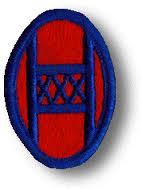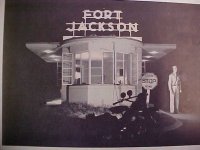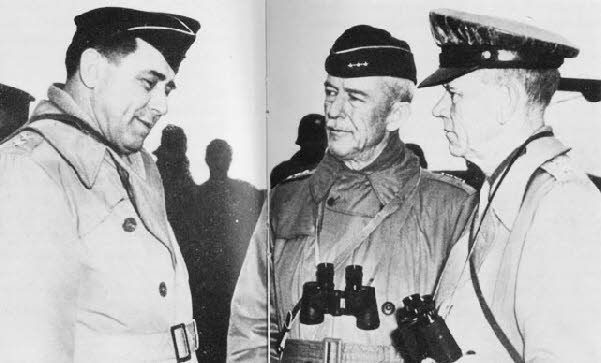

History
The 30th Division was created on July 18, 1917, and was formally activated into Federal service in August 1917 at Camp Sevier, South Carolina, and was composed of National Guard units from North and South Carolina and Tennessee.
The Division was named after the famed and illustrious soldier and President, Andrew "Old Hickory" Jackson, who was born near the North/South Carolina border, and rising to fame in Tennessee, where he provided some regional flavor to the tightly knit group of soldiers that he led there during the Indian Wars.
The Division's logo is an obvious link to this heritage, being represented by an "O" and "H" with the Roman Numeral "XXX" in Royal Blue on a background of Scarlet Red in the center. During World War I, the shoulder patch (logo) was worn horizontally, which actually was the incorrect orientation, which was not discovered and corrected until the mid 1920's.
The 30th Division served overseas with the American Expeditionary Forces during World War I, and on 29 September 1918, distinguished itself in the Somme Offensive by smashing its way through the famed and so called impregnable 'Hindenburg Line', a victory that hastened the end of World War I. It also participated in the Battles of La Selle, St. Mihiel and in the Meuse-Argonne, and during these battles, its men were awarded twelve (12) Congressional Medals of Honor.
After World War I, the 30th Division was deactivated from Federal service and reverted back to its National Guard role in its respective States.

World War II:
Again in September 1940, the 30th Infantry Division, composed of the National Guard troops of North & South Carolina, Tennessee and Georgia, was inducted into Federal service at Ft. Jackson, S.C., also named after Andrew Jackson. Here it spent over one year in organizing and preliminary training.
Later, the 30th Infantry Division received a major part of its advanced training at Camp Blanding, near Starke, Florida, to where it had been transferred in October of 1942, and remained there until the summer of 1943, after losing most of its trained Officers and Men to cadre new divisions throughout the country. After receiving replacements from nearly every State in the union, the Division continued its training during 1943 at Camp Blanding, Florida, Camp Forrest Tennessee and Camp Atterbury, Indiana, where it made its final preparations prior to moving overseas up until February of 1944.


Europe
On 12 February 1944, the 30th Infantry Division sailed for Europe, and settled on the south coast of England to participate in further training for the coming invasion of the Continent "at some time in the future".
In June of 1944, after being fully trained and prepared for the greatest invasion of all times, the 30th Infantry Division started crossing the English Channel to France on 6 June, D-Day, to replace some of the units of the 29th Infantry Division which had become almost immediately lost during the initial attack of the invasion, and then the balance of the Division went into the beaches of Normandy, Omaha Beach on D plus 4, the 10th of June and up through the 15th, and was almost immediately committed into combat against the experienced German Army.

During combat, the 30th Infantry Division was known as the "Workhorse of the Western Front". It was also familiarly known as "Roosevelt's SS Troops", so named by the German High Command because of the consistent vigor and terrific pressure the 30th Infantry Division brought to bear on Hitler's 'elite' 1st SS Division. The German 'elite' 1st SS Division was the main force of resistance just prior to the breakthrough at St. LO, and again at Mortain, which the 30th Infantry Division literally tore to shreds, thereby allowing Gen. George Patton's armored forces of the U.S. Third Army to go forward and race across France, thereby shortening the war by many months. The German 1st SS Division was then reorganized over the next few months, and was again faced by the 30th Infantry Division in the "Battle of the Bulge", during the great Ardennes-Alsace Offensive, near Malmedy, Belgium, during the winter of 1944-45. Again the 30th Infantry Division tore to shreds this 'elite' enemy division, which was never again to return to battle.
End of the war
The 30th Infantry Division was initially organized and engaged in its early training under the command of Maj. Gen. Henry D. Russell, followed by Maj. Gen. William Simpson, who later became the U.S. Ninth Army Commander, to which the 30th Infantry Division was attached. Later, the division spent the rest of its training days under the command of Maj. Gen. Leland S. Hobbs, and it remained under his command throughout the entire war, including the days when the link-up was made with the Russian Army at Magdeburg, Germany on the Elbe River in April of 1945.
Immediately following the end of the war, the 30th Infantry Division spent the next two months in Occupation on the border of Czechoslovakia and Germany.
Shortly after the end of their Occupation duties, in early August 1945, the 30th Infantry Division returned to the United States on the Queen Mary and the USS General Black, and was soon deactivated at Ft. Jackson, S.C. on 25 November 1945.
This ended the illustrious service of the 30th Infantry Division in WWII.









